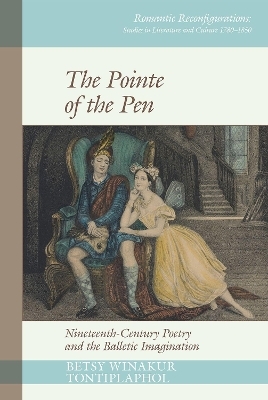
The Pointe of the Pen
Nineteenth-Century Poetry and the Balletic Imagination
Seiten
2024
Liverpool University Press (Verlag)
978-1-80207-360-7 (ISBN)
Liverpool University Press (Verlag)
978-1-80207-360-7 (ISBN)
Originally a courtly art, ballet experienced dramatic evolution (but never, significantly, theprospect of extinction) as attitudes toward courtliness itself shifted in the aftermath of the French Revolution.
Originally a courtly art, ballet experienced dramatic evolution (but never, significantly, the
prospect of extinction) as attitudes toward courtliness itself shifted in the aftermath of the French Revolution. As a result, it afforded a valuable model to poets who, like Wordsworth and his successors, aspired to make the traditionally codified, formal, and, to some degree, aristocratic art of poetry compatible with “the very language of men” and, therefore, relevant to a new
class of readers. Moreover, as a model, ballet was visible as well as valuable. Dance historians recount the extraordinary popularity of ballet and its practitioners in the nineteenth century, and The Pointe of the Pen challenges literary historians’ assertions – sometimes implicit, sometimes explicit – that writers were immune to the balletomania that shaped both Romantic and Victorian England, as well as Europe more broadly. The book draws on both primary documents (such as dance treatises and performance reviews) and scholarly histories of dance to describe the ways in which ballet's unique culture and aesthetic manifest in the forms, images, and ideologies of significant poems by Wordsworth, Byron, Shelley, and Barrett Browning.
Originally a courtly art, ballet experienced dramatic evolution (but never, significantly, the
prospect of extinction) as attitudes toward courtliness itself shifted in the aftermath of the French Revolution. As a result, it afforded a valuable model to poets who, like Wordsworth and his successors, aspired to make the traditionally codified, formal, and, to some degree, aristocratic art of poetry compatible with “the very language of men” and, therefore, relevant to a new
class of readers. Moreover, as a model, ballet was visible as well as valuable. Dance historians recount the extraordinary popularity of ballet and its practitioners in the nineteenth century, and The Pointe of the Pen challenges literary historians’ assertions – sometimes implicit, sometimes explicit – that writers were immune to the balletomania that shaped both Romantic and Victorian England, as well as Europe more broadly. The book draws on both primary documents (such as dance treatises and performance reviews) and scholarly histories of dance to describe the ways in which ballet's unique culture and aesthetic manifest in the forms, images, and ideologies of significant poems by Wordsworth, Byron, Shelley, and Barrett Browning.
Betsy Winakur Tontiplaphol is Associate Professor of English at Trinity University, San Antonio, Texas.
Introduction: Every
Savage Can Dance: English Poets and Ballet
1. Sprightly Dance and Other Measured Motion:
Wordsworth and Balletic Expressivity
2. Classic Pas – Sans Flaw: Byron, Shelley, and the
Balletic Body
3. Tiptoe Aspirations:
Barrett Browning and Balletic Mobility
| Erscheinungsdatum | 05.03.2024 |
|---|---|
| Reihe/Serie | Romantic Reconfigurations: Studies in Literature and Culture 1780-1850 ; 15 |
| Verlagsort | Liverpool |
| Sprache | englisch |
| Maße | 156 x 234 mm |
| Themenwelt | Geisteswissenschaften ► Sprach- / Literaturwissenschaft ► Anglistik / Amerikanistik |
| Geisteswissenschaften ► Sprach- / Literaturwissenschaft ► Literaturgeschichte | |
| Geisteswissenschaften ► Sprach- / Literaturwissenschaft ► Literaturwissenschaft | |
| ISBN-10 | 1-80207-360-4 / 1802073604 |
| ISBN-13 | 978-1-80207-360-7 / 9781802073607 |
| Zustand | Neuware |
| Haben Sie eine Frage zum Produkt? |
Mehr entdecken
aus dem Bereich
aus dem Bereich
Poetik eines sozialen Urteils
Buch | Hardcover (2023)
De Gruyter (Verlag)
59,95 €
Buch | Softcover (2024)
belleville (Verlag)
20,00 €


